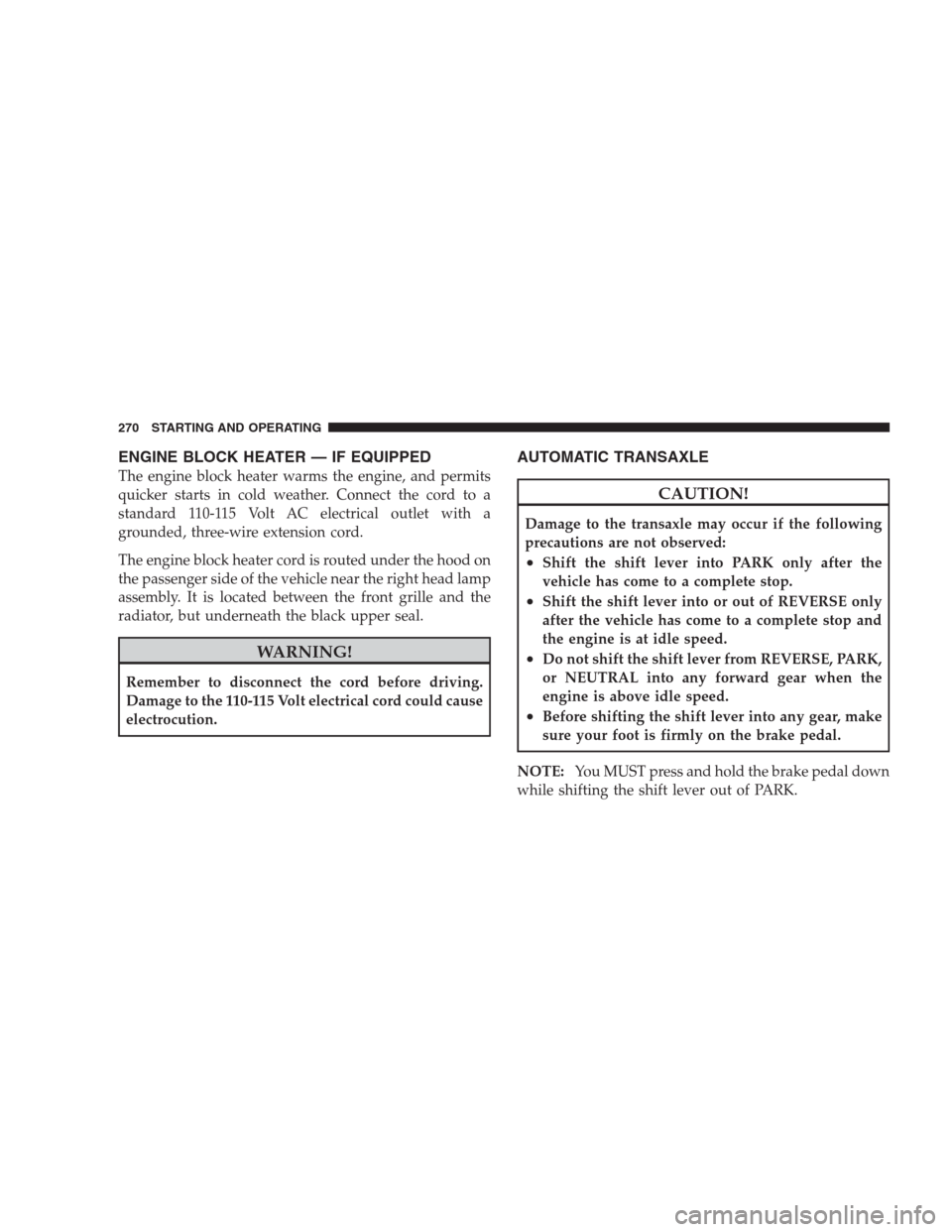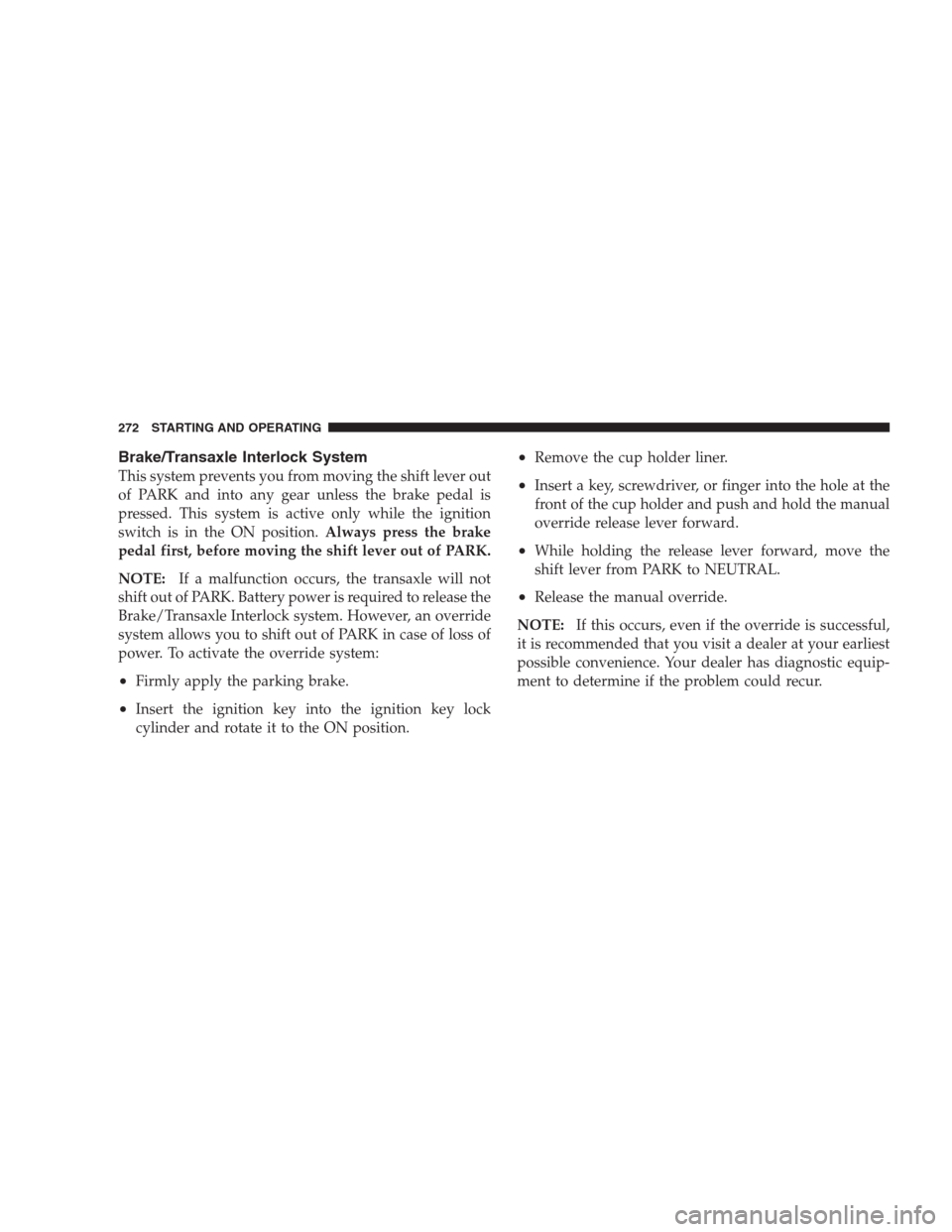Page 191 of 475

The light also will turn on when the parking brake is
applied with the ignition switch in the ON position.
NOTE:This light shows only that the parking brake is
applied. It does not show the degree of brake application.
20. Turn Signal Indicators
The arrows will flash in unison with the exterior
turn signal, when using the turn signal lever.
21. Front Fog Light Indicator — If Equipped
This light indicates when the front fog lights are
ON.
22. Electronic Stability Program (ESP) Indicator Light
/ Brake Assist System (BAS) Warning Light
The malfunction lamp for the Electronic Stabil-
ity Program (ESP) is combined with Brake
Assist System (BAS). The yellow “ESP/BAS
Warning Lamp” comes on when the ignition
switch is turned to the “ON” position. The “ESP/BASWarning Lamp” should turn off with the engine running.
If the “ESP/BAS Warning Lamp” comes on continuously
with the engine running, a malfunction has been detected
in either the ESP or the BAS system. If this light remains
on after several ignition cycles, and the vehicle has been
driven several miles at speeds greater than 30 mph
(48 km/h), see an authorized dealer as soon as possible.
23. Anti-Lock Brake (ABS) Light — If Equipped
This light monitors the ABS. This light will
come on when the ignition key is turned to the
ON position and may stay on for approxi-
mately three seconds.
If the ABS light remains on or comes on during driving,
it indicates that the Anti-Lock portion of the brake system
is not functioning and that service is required, however,
the conventional brake system will continue to operate
normally provided that the BRAKE warning light is not
on.
UNDERSTANDING YOUR INSTRUMENT PANEL 189
4
Page 192 of 475

If the ABS light is on, the brake system should be serviced
as soon as possible to restore the benefit of Anti-Lock
Brakes.
The ABS warning light should be checked frequently to
assure that it is operating properly. Turn the ignition key
to the on position, but do not start the vehicle. The light
should come on. If the light does not come on, have the
system inspected by an authorized dealer.
24. Tire Pressure Monitoring Telltale Light
Each tire, including the spare (if provided),
should be checked monthly, when cold and
inflated to the inflation pressure recommended
by the vehicle manufacturer on the vehicle
placard or tire inflation pressure label. (If your vehicle
has tires of a different size than the size indicated on the
vehicle placard or tire inflation pressure label, you should
determine the proper tire inflation pressure for those
tires.)As an added safety feature, your vehicle has been
equipped with a Tire Pressure Monitoring System
(TPMS) that illuminates a low tire pressure telltale when
one or more of your tires is significantly under-inflated.
Accordingly, when the low tire pressure telltale illumi-
nates, you should stop and check your tires as soon as
possible, and inflate them to the proper pressure. Driving
on a significantly under-inflated tire causes the tire to
overheat and can lead to tire failure. Under-inflation also
reduces fuel efficiency and tire tread life, and may affect
the vehicle’s handling and stopping ability.
Please note that the TPMS is not a substitute for proper
tire maintenance, and it is the driver ’s responsibility to
maintain correct tire pressure, even if under-inflation has
not reached the level to trigger illumination of the TPMS
low tire pressure telltale.
190 UNDERSTANDING YOUR INSTRUMENT PANEL
Page 265 of 475
STARTING AND OPERATING
CONTENTS
�Starting Procedures.................... 267
▫Normal Starting..................... 267
▫Tip Start Feature..................... 268
▫Extremely Cold Weather (Below�20°F Or
�29°C)............................ 268
▫If Engine Fails To Start................ 268
▫After Starting....................... 269
�Engine Block Heater — If Equipped........ 270
�Automatic Transaxle................... 270▫Brake/Transaxle Interlock System......... 272
▫Automatic Transaxle Ignition Interlock
System............................ 273
▫4 Speed/6 Speed Automatic Transaxle..... 273
�AutoStick�— If Equipped............... 277
▫Operation......................... 277
▫General Information.................. 278
�Driving On Slippery Surfaces............. 279
▫Acceleration........................ 279
5
Page 266 of 475

▫Traction........................... 279
�Driving Through Water................. 280
▫Flowing/Rising Water................. 280
▫Shallow Standing Water............... 280
�Power Steering....................... 282
▫Power Steering Fluid Check............. 282
�Parking Brake........................ 283
�Anti—Lock Brake System (ABS)........... 285
�Brake System........................ 288
▫Anti-Lock Brake System — If Equipped.... 289
�Electronic Brake Control System........... 292
▫Anti-Lock Brake System (ABS)........... 292
▫Traction Control System (TCS)........... 292▫Brake Assist System (BAS).............. 293
▫Electronic Stability Program (ESP)........ 294
�Tire Safety Information................. 297
▫Tire Markings....................... 297
▫Tire Identification Number (TIN)......... 301
▫Tire Loading And Tire Pressure.......... 302
�Tires — General Information............. 306
▫Tire Pressure....................... 306
▫Tire Inflation Pressures................ 307
▫Radial-Ply Tires..................... 309
▫Compact Spare Tire — If Equipped....... 310
▫Limited Use Spare — If Equipped........ 311
▫Tire Spinning....................... 312
264 STARTING AND OPERATING
Page 269 of 475

STARTING PROCEDURES
Before starting your vehicle, adjust your seat, adjust both
inside and outside mirrors, and fasten your seat belt.
Make sure all occupants have securely fastened their seat
belts.
WARNING!
•Never leave children alone in a vehicle. Leaving
children in a vehicle unattended is dangerous for a
number of reasons. A child or others could be
seriously or fatally injured. Do not leave the key in
the ignition. A child could operate power win-
dows, other controls, or move the vehicle.
•Do not leave animals or children inside parked
vehicles in hot weather; interior heat buildup may
cause serious injury or death.
(Continued)
WARNING! (Continued)
•Be sure to turn off the engine and remove the key
from the ignition switch if you want to rest or
sleep in your car. Accidents can be caused by
inadvertently moving the gear selection lever or
by pressing the accelerator pedal. This may cause
excessive heat in the exhaust system, resulting in
overheating and vehicle fire which may cause
serious or fatal injuries.
Normal Starting
The shift lever must be in the PARK or NEUTRAL
position before you can start the engine. Apply the brakes
before shifting to any driving gear.
NOTE:Normal starting of either a cold or a warm
engine does not require pumping or depressing the
accelerator pedal.
STARTING AND OPERATING 267
5
Page 272 of 475

ENGINE BLOCK HEATER — IF EQUIPPED
The engine block heater warms the engine, and permits
quicker starts in cold weather. Connect the cord to a
standard 110-115 Volt AC electrical outlet with a
grounded, three-wire extension cord.
The engine block heater cord is routed under the hood on
the passenger side of the vehicle near the right head lamp
assembly. It is located between the front grille and the
radiator, but underneath the black upper seal.
WARNING!
Remember to disconnect the cord before driving.
Damage to the 110-115 Volt electrical cord could cause
electrocution.
AUTOMATIC TRANSAXLE
CAUTION!
Damage to the transaxle may occur if the following
precautions are not observed:
•Shift the shift lever into PARK only after the
vehicle has come to a complete stop.
•Shift the shift lever into or out of REVERSE only
after the vehicle has come to a complete stop and
the engine is at idle speed.
•Do not shift the shift lever from REVERSE, PARK,
or NEUTRAL into any forward gear when the
engine is above idle speed.
•Before shifting the shift lever into any gear, make
sure your foot is firmly on the brake pedal.
NOTE:You MUST press and hold the brake pedal down
while shifting the shift lever out of PARK.
270 STARTING AND OPERATING
Page 273 of 475
WARNING!
•It is dangerous to move the shift lever out of or if
the engine speed is higher than idle speed. If your
foot is not firmly on the brake pedal, the vehicle
could accelerate quickly forward or in reverse. You
could lose control of the vehicle and hit someone
or something. Only shift into gear when the en-
gine is idling normally and when your right foot is
firmly on the brake pedal.
(Continued)
WARNING! (Continued)
•Unintended movement of a vehicle could injure
those in and near the vehicle. As with all vehicles,
you should never exit a vehicle while the engine is
running. Before exiting a vehicle, you should
always shift the vehicle into PARK, remove the
key from the ignition, and apply the parking
brake. Once the key is removed from the ignition,
the shift lever is locked in the PARK position,
securing the vehicle against unwanted movement.
Furthermore, you should never leave children un-
attended inside a vehicle.
STARTING AND OPERATING 271
5
Page 274 of 475

Brake/Transaxle Interlock System
This system prevents you from moving the shift lever out
of PARK and into any gear unless the brake pedal is
pressed. This system is active only while the ignition
switch is in the ON position.Always press the brake
pedal first, before moving the shift lever out of PARK.
NOTE:If a malfunction occurs, the transaxle will not
shift out of PARK. Battery power is required to release the
Brake/Transaxle Interlock system. However, an override
system allows you to shift out of PARK in case of loss of
power. To activate the override system:
•Firmly apply the parking brake.
•Insert the ignition key into the ignition key lock
cylinder and rotate it to the ON position.
•Remove the cup holder liner.
•Insert a key, screwdriver, or finger into the hole at the
front of the cup holder and push and hold the manual
override release lever forward.
•While holding the release lever forward, move the
shift lever from PARK to NEUTRAL.
•Release the manual override.
NOTE:If this occurs, even if the override is successful,
it is recommended that you visit a dealer at your earliest
possible convenience. Your dealer has diagnostic equip-
ment to determine if the problem could recur.
272 STARTING AND OPERATING